Halloween isn't just Arthur's Day for tots

Traditionally it was a time when wraith-like creatures haunted the darkness, causing havoc in the world of the living.
But it’s not all about teenagers drinking cans around burning pallets. It’s not just Arthur’s Day for tots.
Halloween was originally a pagan Irish festival Samhain which signified the end of summer and onset of winter. Samhain was noteworthy for the general debauchery that the pagans excelled at and made the new Christians regret their choice. Pope Boniface put an end to it by appropriating the festival as a commemoration of all the saints and martyrs — part of the early-Church’s strident anti-craic policy.
(Luckily we are gradually returning all former pagan festivals to their licentious former glory.)
Bobbing for apples is not, as it turns out, an interrogation technique but a vestige of the worship of Pomana, the Roman goddess of fruitfulness who, incidentally, was married to the faun Vertumnus — the inspiration for Narnia’s Mr Tumnus. (How do you like dem apples?)
Trick-or-treating evolved from souling. In the Middle Ages, poor people would go from house to house to say prayers for the dead in exchange for food. By contrast, trick-or-treating is now a far more commercial enterprise. Often children will have little direct debit forms and will greet the householder with: “Excuse me, could I take a few minutes of your time to tell you about the good work we are doing with sweets”.
With the growth of a new tradition of Great [insert nationality] Bake-Offing, another custom is reviving: the Barm-is-it-BARM?-I-thought-it-was-BARN-brack. It’s a cheap but memorable thrill when you first find a ring in the brack — provided you don’t find it with your throat muscles or a now-broken lower molar. The ring signified romance. If you found a coin, prosperity was guaranteed. However, if you found a rag, your financial future was in doubt. Barmbracks manufactured at the moment are almost 40% cloth. And the currant position is unlikely to change.
Like many of our festivals, the American influence has been undeniable. If you think of a carved-out vegetable with Halloween connotations, most people will guess pumpkin. In fact it was originally turnips that were carved. They were used as lanterns by the guisers.
Finally we return to the bonfire — at this time of year the single largest employer of urban males in the 5-18 age group. At Samhain, druids would burn the bones of the animals they had slaughtered for the winter. It was meant to ward off spirits and people walked between the flames as a cleansing ritual. It was also a huge relief for druids who had been holding onto the bones, intending to use them for stock, but you know the way it is with stock — it’s much easier to buy the cubes. And it left more time for eating sweets.
* Colm O’Regan’s book That’s More Of It Now — The Second Book Of Irish Mammies is out now.














